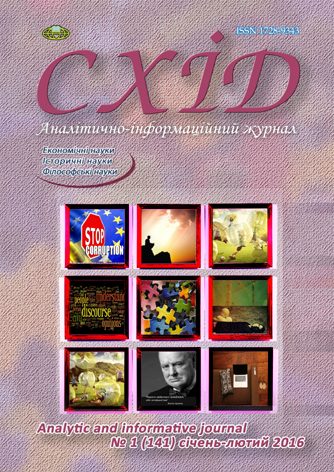Green building financing
DOI:
https://doi.org/10.21847/1728-9343.2016.1(141).61374Keywords:
energy-efficient construction, real estate development, loans, project financing, investment loans, investment valuation, the effect of energy efficiency, green building financingAbstract
The article is devoted to the problem of green buildings financing. It is noted that bank lending can be a major source of funds for construction. However, current trends in the economy of Ukraine shows that credit, especially lending to construction, is in poor condition. Accordingly, there is a need to explore the possibility of additional measures that can be applied to bringing financial resources into the construction.
The author brings evidence in favor of feasibility of raising funds for construction in the form of investment loans. For investment loans, the most important feature is specifications of the particular project that is an object of an investment. In evaluating the appropriateness of investment UNIDO methodology is applied. It takes into account both quantitative and qualitative indicators.
Comparison of conventional and energy-efficient construction project financing is presented in the article. The comparison takes into account a number of indicators that demonstrate that energy-efficient construction has several advantages in terms of investment attractiveness. Comprehensive analysis shows that these investment projects have higher net present value, the best indicators of the criterion Bruno as well as commercial, institutional, environmental and social criteria. The disadvantages include a certain uncertainty that is caused by the unclear future cost of energy, but to some extent, that is offset by the positive impact of numerous macroeconomic factors.
The author cites studies conducted by many scientists, who argue that energy-efficient buildings are somewhat supreme in construction costs, but create competitive advantages, reflected in the reduction of operating costs, increase in the size of rent payments and total returns.
Downloads
References
The Verkhovna Rada ofUkraine(2015), The Law of Ukraine "On energy saving", available at: http://zakon2.rada.gov.ua/laws/show/74/94-%D0%B2%D1%80, (Accessed 15 January 2016) (ukr).
The National Bank ofUkraine(2015), "Bulletin of the National Bank ofUkraine", available at: http://www.bank.gov.ua/control/uk/publish/category?cat_id=57897, (Accessed 20 February 2016) (ukr).
Brunko V. M. (2015), "TAABS - new class of building systems for energy saving and ecology", available at: http://taabs.org/taabs-noviy-klas-budivelnih-sistem-dlya-energozberezhennya-i-ekologiyi/, (Accessed 10 February 2016) (ukr).
Dodonov B. (2015), "Ukraine Energy Monitoring", available at: http://www.ua.undp.org/content/dam/ukraine/docs/EE/%D0%9E%D1% 82%D1%87%D0%B5%D1%82%20%D0%9C%D0%95%D0%A3_%D0%B2%D1%8B%D1%87%D0%B8%D1%82%D0%B0%D0%BD%20061015-0.pdf, (Accessed 15 February 2016) (ukr).
Diupon P. (2014), "Review of energy efficiency approaches and financing models", available at: http://www.carecprogram.org/uploads/events/2014/Energy-Efficiency-Seminar-KL/Presentation-Materials/009_104_209_Session-6-ru.pdf, (Accessed 10 February 2016) (rus).
Zhukov D. (2015), "Belarusian passive house: To Be, Or Not To Be", Arkhіtektura і stroіtelstvo, vol. 1(209), available at: http://ais.by/story/12319, (Accessed: 20 December 2015) (rus).
Kanhro M. V. (2011), Metody otsenki investitsyonnykh proektov [Methods for evaluation of investment projects: a training manual], UlHTU,Ulyanovsk,Russia(rus).
Komelina O. V. and Scherbinina S. A. (2014), "Modern problems of energy efficiency of housing construction in Ukraine", Problemy ekonomiky, vol. 3, available at: http://nbuv.gov.ua/UJRN/Pekon_2014_3_15, (Accessed: 18 December 2015) (ukr).
Molodid O. O. (2015) "Projects of raising the energy efficiency of objects: characteristics of funding in Ukraine", Efektyvna ekonomika, vol. 11, available at: http://www.economy.nayka.com.ua/?op=1&z=4594, (Accessed: 21 December 2015) (ukr).
Peresada A. A. and Maiorova T. V. (2002), Investytsiine kredytuvannia [Investment lending], KNEU,Kyiv,Ukraine(ukr).
Ryzhkova G. V. (2013), "Threats and prospects of bank lending for energy efficiency projects of enterprises", Aktualni problemy ekonomiky, vol. 4, pp. 226-231 (ukr).
Riabova S. (2015), "Financing energy efficiency projects: features of the economic justification and the role of banks", Bankawski vesnik, vol. 8, available at: http://www.nbrb.by/bv/articles/10156.pdf, (Accessed: 18 December 2015) (rus).
Sanytskyi M. A., Pozniak O. R. and Bidnyk I. V. (2008), "Analysis of international and domestic experience in the use of energy efficient technologies in the construction industry", available at: http://cstei.lviv.ua/upload/pub/Energo/1259276548_34.pdf, (Accessed: 5 December 2015) (ukr).
Sivayev S. B. (2011), "The establishment and activities of energy service companies and energy performance contracts inRussia. Volume 1", available at: https://www.wwf.ru/data/publ/552/esco-sivaev.pdf (Accessed: 5 January 2015) (rus).
Stepanenko V. "The strategy of upgrading buildings and district heating systemsUkraine- challenges for cities inUkraine", available at: http://www.ecosys.com.ua/press/presentations/strategy_building_renovation_ukraine.pdf (Accessed: 2 January 2015) (ukr).
Timchenko R. O., Krishko D. A., Shevchuk O. V. and Petrova L. V. (2012) "New approaches in designing energy efficient buildings", Visnyk Kryvorizkoho natsionalnoho universytetu, vol. 31, pp. 3-5 (ukr).
Fuller S. (2010), "Life-Cycle Cost Analysis (LCCA)", available at: http://www.wbdg.org/resources/lcca.php, (Accessed: 04 January 2016) (engl).
Jan Mueller, Jim Hansen, Stephen P. A. Brown (2015), "Oil and the Global Economy", available at: http://www.resilience.org/stories/2015-10-08/oil-and-the-global-economy, (Accessed: 2 February 2015) (engl).
Pierce C. J (2013) "Financing green buildings", Ph.D. Thesis, S.M. Massachusetts Institute of Technology,Boston,USA(engl).
Eichholtz P., Kok N. and Quigley J. (2010) "Doing Well by Doing Good? Green Office Buildings", American Economic Review, vol. 100(5), available at: http://urbanpolicy.berkeley.edu/pdf/AER_Revised_Proof_101910.pdf, (Accessed 10 January 2016) (engl).
Downloads
Published
How to Cite
Issue
Section
License
Copyright (c) 2016 Pavlo Brunko

This work is licensed under a Creative Commons Attribution-NonCommercial-NoDerivatives 4.0 International License.
1. Authors bear responsibility for the accuracy of facts, quotations, numbers and names used.
2. Manuscripts are not sent back.
3. The publisher does not always agree with the authors' opinion.
4. The authors reserve the right to authorship of the work and pass the first publication right of this work to the journal under the terms of a Creative Commons Attribution-NonCommercial-NoDerivatives 4.0 International License. This license allows others to distribute (copy) the published work for non-commercial purposes, provided there is mandatory attribution to its authors and a link to the first publication in our journal.
5. The authors have the right to conclude separate supplement agreements that relate to non-exclusive work distribution in the form in which it has been published by the journal (for example, to upload the work to the online storage of the journal or publish it as part of a monograph), provided that the reference to the first publication of the work in this journal is included.

